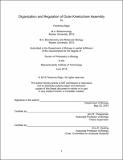| dc.contributor.advisor | Iain M. Cheeseman. | en_US |
| dc.contributor.author | Rago, Florencia | en_US |
| dc.contributor.other | Massachusetts Institute of Technology. Department of Biology. | en_US |
| dc.date.accessioned | 2015-09-17T17:41:43Z | |
| dc.date.available | 2015-09-17T17:41:43Z | |
| dc.date.copyright | 2015 | en_US |
| dc.date.issued | 2015 | en_US |
| dc.identifier.uri | http://hdl.handle.net/1721.1/98546 | |
| dc.description | Thesis: Ph. D., Massachusetts Institute of Technology, Department of Biology, 2015. | en_US |
| dc.description | This electronic version was submitted by the student author. The certified thesis is available in the Institute Archives and Special Collections. | en_US |
| dc.description | Cataloged from student-submitted PDF version of thesis. | en_US |
| dc.description | Includes bibliographical references (pages 125-138). | en_US |
| dc.description.abstract | The kinetochore provides the connection between chromosomes and spindle microtubules. Defining the molecular architecture of the core kinetochore components is critical for understanding the mechanisms by which the kinetochore directs chromosome segregation. The KNL1/Mis12 complex/Ndc80 complex (KMN) network acts as the primary microtubule-binding interface at kinetochores, and provides a platform for recruitment of regulatory proteins. The results in this thesis demonstrate that the CENP-C and CENP-T inner kinetochore receptors form separate scaffolds for KMN network assembly. Initial biochemical results suggested a non-canonical assembly pathway mediated by a direct interaction between CENP-T and the Ndc80 complex. These results were further verified and expanded upon in cells using an ectopic targeting approach to allow careful analysis of the pathways independently of one another. The data presented here demonstrate that in addition to forming two pathways, the CENP-C and CENP-T based assemblies are each constructed uniquely, showing both distinct organization of the KMN components as well as different modes of regulation. Analysis of the CENP-C based assembly pathway has previously defined the canonical architecture of the KMN network as a stable unit that associates with CENP-C via a direct interaction mediated by the Mis12 complex, and the data herein additionally shows that assembly of this pathway is regulated at least in part by Aurora B kinase activity. In contrast, the CENP-T protein forms a direct, CDK-dependent interaction with the Ndc80 complex, and this interaction is required for downstream recruitment of KNL1 and the Mis12 complex, resulting in a novel recruitment pathway for the KMN network. Together these results allow us to generate a new and more detailed molecular model for the assembly of the core structural components of the kinetochore. | en_US |
| dc.description.statementofresponsibility | by Florencia Rago. | en_US |
| dc.format.extent | 148 pages | en_US |
| dc.language.iso | eng | en_US |
| dc.publisher | Massachusetts Institute of Technology | en_US |
| dc.rights | M.I.T. theses are protected by copyright. They may be viewed from this source for any purpose, but reproduction or distribution in any format is prohibited without written permission. See provided URL for inquiries about permission. | en_US |
| dc.rights.uri | http://dspace.mit.edu/handle/1721.1/7582 | en_US |
| dc.subject | Biology. | en_US |
| dc.title | Organization and regulation of outer kinetochore assembly | en_US |
| dc.type | Thesis | en_US |
| dc.description.degree | Ph. D. | en_US |
| dc.contributor.department | Massachusetts Institute of Technology. Department of Biology | |
| dc.identifier.oclc | 920672814 | en_US |
